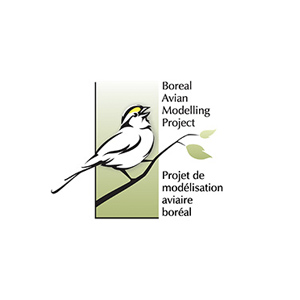BOREAL AVIAN MODELLING PROJECT
Bird Conservation Reaches Continental Scale through New Partnership with the Boreal Avian Modelling Project
Applying Data-Driven Measures to Evaluate and Improve the Conservation Value of Managed Forests for Birds
Why this project matters
The boreal forest, stretching from Alaska to Newfoundland, is an important global bastion of bird life. Billions of birds migrate to and from the boreal forest every year from as far away as South America. Species like the Canada warbler, for example, fly back and forth from wintering in the northern Andes to breeding in Canada’s boreal forest. Approximately 80% of the Canada warbler’s global breeding range is located in the boreal, and it breeds in all provinces and territories. It is listed as a threatened species under Canada’s Species at Risk Act (SARA). With about 89 million hectares/220 million acres of forestland certified to SFI in Canada, SFI has the scale to proactively and positively influence bird conservation on well‑managed, forest landscapes.
How the project helps conserve biodiversity
A grant from the SFI Conservation and Community Partnerships Grant Program is supporting the University of Alberta’s Boreal Avian Modelling (BAM) Project. The BAM project is a partnership of many organizations led by the University of Alberta, Université Laval and Environment and Climate Change Canada. The broader partnership includes academic institutions, government agencies and environmental NGOs.
BAM was created to develop models that will help natural resource managers identify important habitats for breeding birds. This work will meet immediate conservation needs, inform current management, and provide future research and monitoring efforts. The results generated by BAM are relevant to those interested in the conservation of over 300 species of birds found in the boreal.
For example, BAM data on the olive-sided flycatcher, which is listed as threatened in Canada, is being used in the Alberta Land Use Framework and other land-use planning exercises to understand how changes in forest age and type will influence its habitat and that of other breeding birds. These types of land‑use scenario models will aid in the development of regional management plans that feed into provincial conservation and stewardship strategies for private and public lands.
SFI’s contribution
SFI has developed strong partnerships across Canada and the U.S. to enhance forest bird conservation, with the BAM project representing the latest in these ongoing efforts. Working with BAM will allow SFI Program Participants to scale up work to a national level, and ultimately inform continental conservation of some species. This will complement the work of a range of SFI partners in establishing and enhancing the conservation value of lands certified to SFI.
The project is also directly supported by SFI Program Participants Canfor, Domtar, Interfor Corporation, Resolute, Tolko, and West Fraser. These companies will provide in-kind data support to help BAM in characterizing the conservation value of their certified land base. These partners will also contribute data, expertise, and analysis coordination.
How the project helps forest managers
The BAM project will continue to build on earlier investigations by SFI Program Participants and other researchers to inform land managers of a range of bird habitat needs. This data will help inform management decisions at a landscape and stand level, including forests of exceptional conservation value. BAM data has the potential to enhance implementation of stand- and landscape-level measures that promote a diversity of habitat types, which is a requirement under the SFI 2015-2019 Forest Management Standard.
This project will quantify the contribution that forests certified to SFI make to the attainment of broadly accepted conservation goals relative to bird habitat. It also underscores the unique role of large blocks of managed forests in contributing to the habitat needs of wide-ranging species, and contributions to landscape-scale objectives.
Partners
This partnership includes academics, conservationists, researchers, SFI Program Participants and Canadian federal and provincial government officials.
Project lead: University of Alberta Department of Renewable Resources, Boreal Avian Modelling Project
Sustainable Forestry Initiative
Canfor (SFI Program Participant)
Domtar (SFI Program Participant)
Interfor Corporation (SFI Program Participant)
Resolute (SFI Program Participant)
Tolko (SFI Program Participant)
West Fraser (SFI Program Participant)
Central Canada SFI Implementation Committee
Western Canada SFI Implementation Committee
American Bird Conservancy
Bird Studies Canada
Université Laval
Environment and Climate Change Canada
Ontario’s Ministry of Natural Resources and Forestry
Canadian Wildlife Service
Saskatchewan Breeding Bird Atlas
Boreal Ecosystems Analysis for Conservation Networks
Canadian Forest Service
Center for Northern Forest Ecosystem Research
Ducks Unlimited Canada
Nature Canada
Related information
Collaborating for Conservation of Managed Forested Landscapes (presentation).
SFI supported a Canada warbler workshop for conservationists and resource managers convened by Nature Canada. Media release.
American Bird Conservancy wins SFI President’s Award for putting SFI’s scale to work for birds. Media release.
Greg Siekaniec, former CEO of Ducks Unlimited Canada, has an op-ed in the Vancouver Sun, Protecting the treasure that is Canada’s boreal forest.

About Boreal Avian Modelling Project
ProThe Boreal Avian Modelling Project is a collaborative science program committed to improved understanding of the ecology of birds and their habitats in the boreal region of North America. Using quantitative modelling techniques and a comprehensive dataset assembled from projects across North America, we derive information on abundance, distribution and habitats of boreal birds, and use this to evaluate and predict the effects of human activity.
Share
COPY LINK: https://forests.org/grantborealavianmodellingprojectii/
